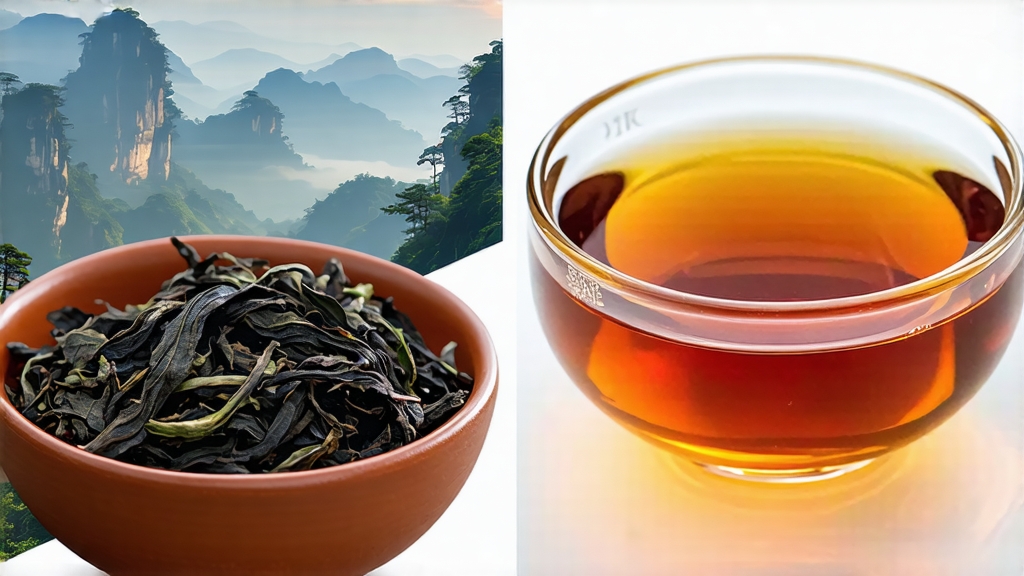
When Chinese tea lovers speak of “rock rhyme”—the mineral echo that lingers on tongue and memory—they are almost always talking about Da Hong Pao, the scarlet-robed sovereign of Wuyi Mountain oolongs. Born on 400-million-year-old shale cliffs in northwest Fujian, this tea carries the scent of weathered stone, orchid, and distant incense; its story is woven with imperial legend, Communist diplomacy, and the meticulous choreography of charcoal fire. For the international drinker who has met Tie Guan Yin’s green vibrancy or Dong Ding’s honeyed depth, Da Hong Pao offers a darker, more brooding profile: a bridge between the floral lift of southern oolong and the malted bass notes of black tea. Understanding it means stepping into a microclimate where morning mist rises like steam from the Hengxi River, where nine-dragon ravines twist between 36 peaks, and where a single mother tree—now retired from plucking—still commands million-dollar insurance.
Historical echoes
The first written record appears in 1385, when a Ming scholar-monk presented “red robe tea” to the Hongwu Emperor; the leaves allegedly cured the imperial princess’s stomach ailment, and the emperor draped the living bushes in scarlet silk as thanks. By the Qing, Da Hong Pao had become tribute tea, couriered north in bamboo-lined chests along the Tea-Horse Road. The 20th century added Cold-War intrigue: in 1972 Mao Zedong gifted 50 g of mother-tree Da Hong Pao to President Nixon, an amount later described by Zhou Enlai as “half of China.” Today the original six mother trees, perched on a 6 m2 ledge at Jiulong Ke, are protected by UNESCO and have not been harvested since 2006; what circulates in the market comes from three sources: cuttings vegetatively propagated from those elders (called “pure pedigree”), offspring grown from seed (less prized), and high-quality bushes planted in the same 60 km2 Wuyi core zone (termed “small variety” or “qizhong”). The latter two are legally sold under the Da Hong Pao name, creating a spectrum that ranges from affordable daily drink to auction superstar.
Terroir and cultivar science
Wuyi’s Danxia landform—purple-red sandstone and gravelly loam—drains fiercely yet retains trace minerals that the tea bush transmutes into polyphenols and aromatic esters. Day-night temperature differentials of 10 °C slow leaf growth, concentrating amino acids, while short-wave UV at 600 m elevation boosts catechin synthesis. The traditional trio of cultivars used for authentic Da Hong Pao are Qi Dan (奇丹, the closest genetic match to the mother trees), Bei Dou (北斗, “North Star,” selected in 1960s), and Que She (雀舌, “Sparrow Tongue,” a small-leaf variant). Each brings a different accent to the final blend: Qi Dan supplies orchid fragrance and a cooling aftertaste; Bei Dou contributes ripe peach and a metallic snap; Que She offers lighter body but lingering jasmine. Commercial “commodity” Da Hong Pao is often a skillful marriage of these and nearby cultivars such as Rou Gui and Shui Xian, assembled by master blenders to approximate the archetypal “rock rhyme.”
Crafting the cliff essence
Plucking occurs in late April, when three half-mature leaves still cup a dewdrop. The pluckers work barefoot on rattan ladders, laying the green into bamboo baskets lined with banana leaf to prevent bruising. Once back at the cottage factory, the leaves undergo the most labor-intensive oolong cycle in China:
- Solar withering: spread 3 cm thick on water-permeable cloth, turned every 10 min for 45–60 min until the leaf edge turns matte and the lamina loses 10 % moisture.
- Indoor withering & shaking: moved to slatted bamboo racks in a humidity-controlled room where they are hand-tossed every hour for 6–8 h; the gentle bruising initiates enzymatic oxidation at the leaf margin while the center stays green, creating the signature “green leaf with red border.”
- Fermentation arrest: when the grassy note recedes and a peachy aroma rises, the leaves are flash-heated in a 230 °C drum for 3 min to kill green enzymes.
- Rolling: twice through